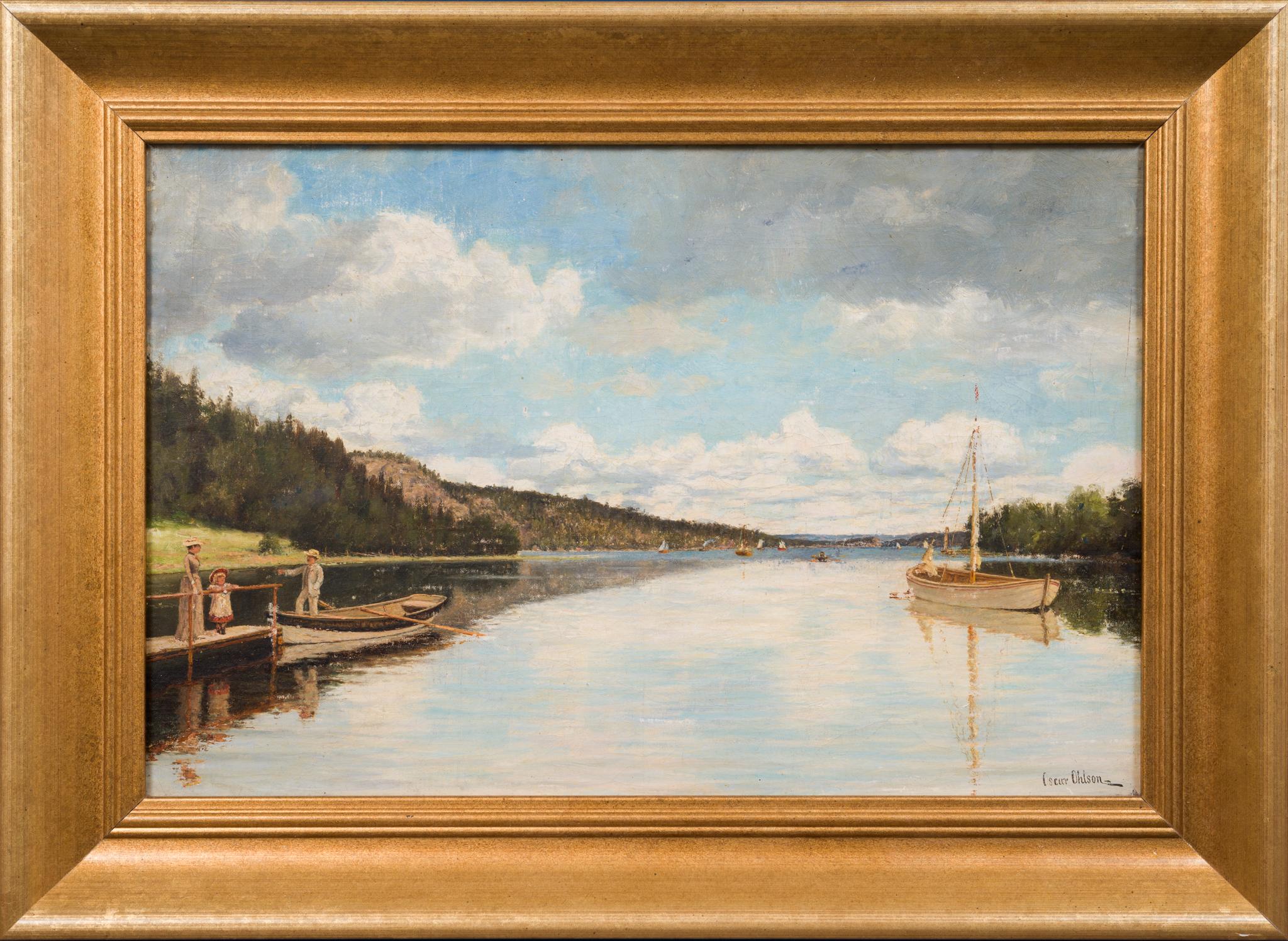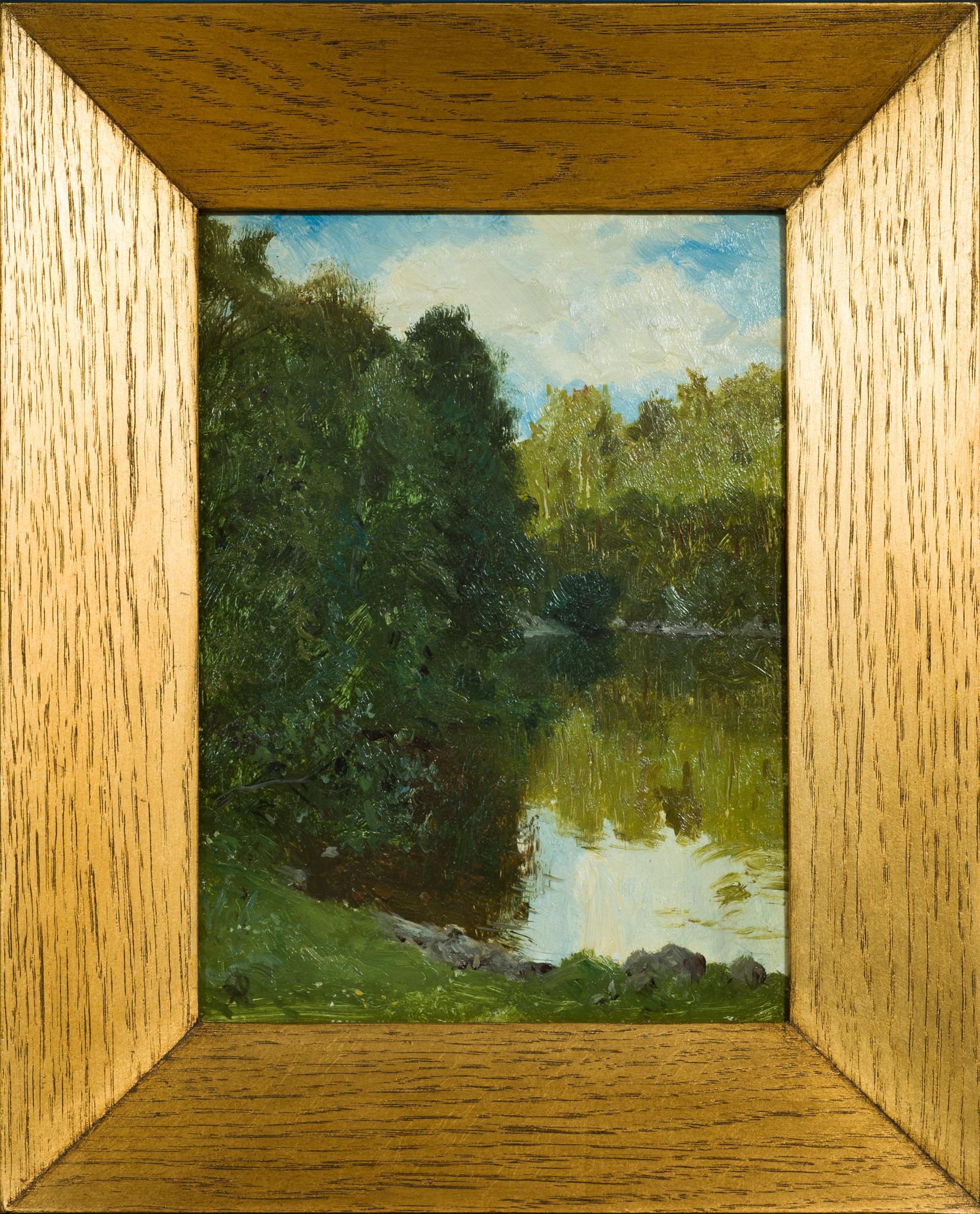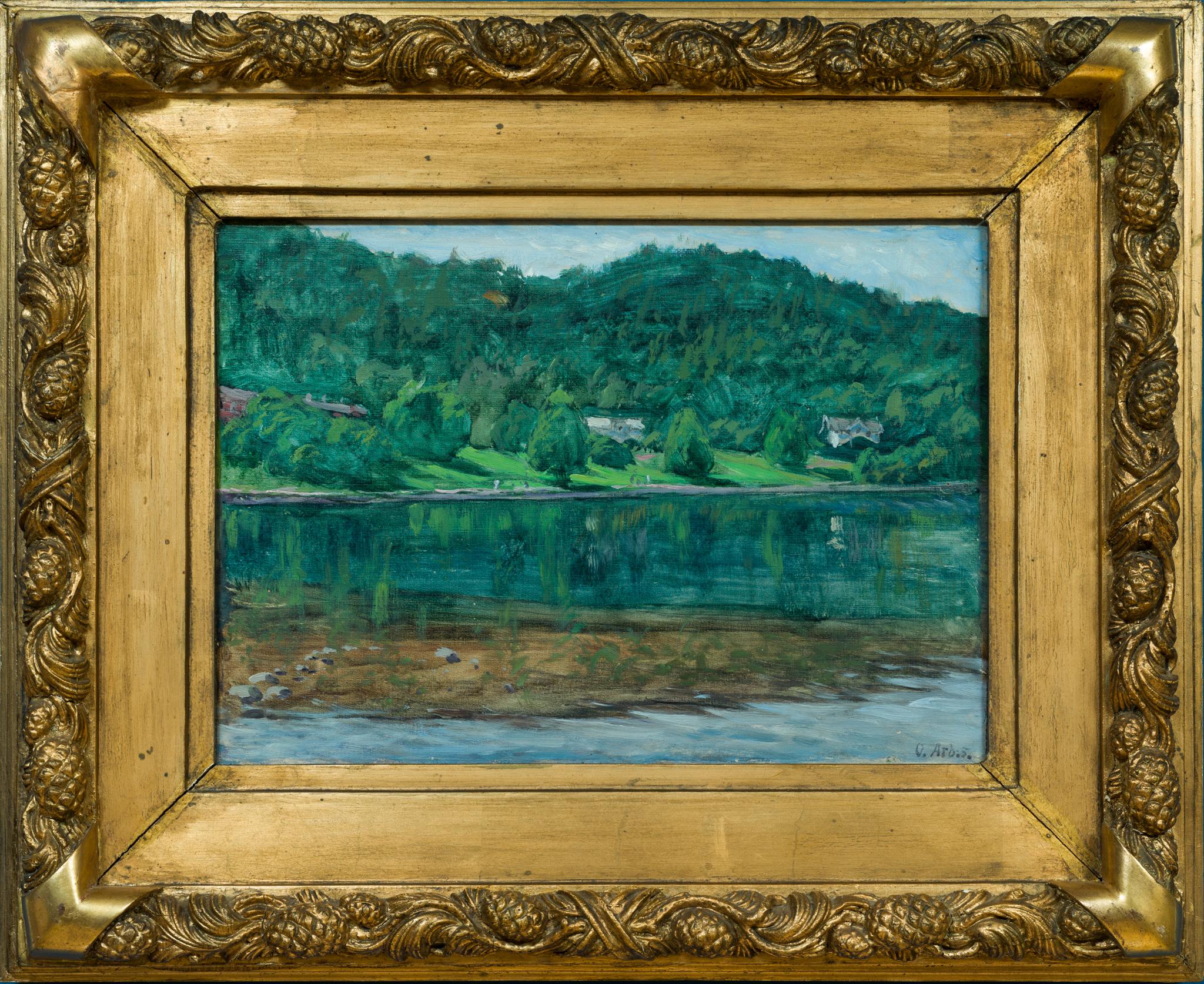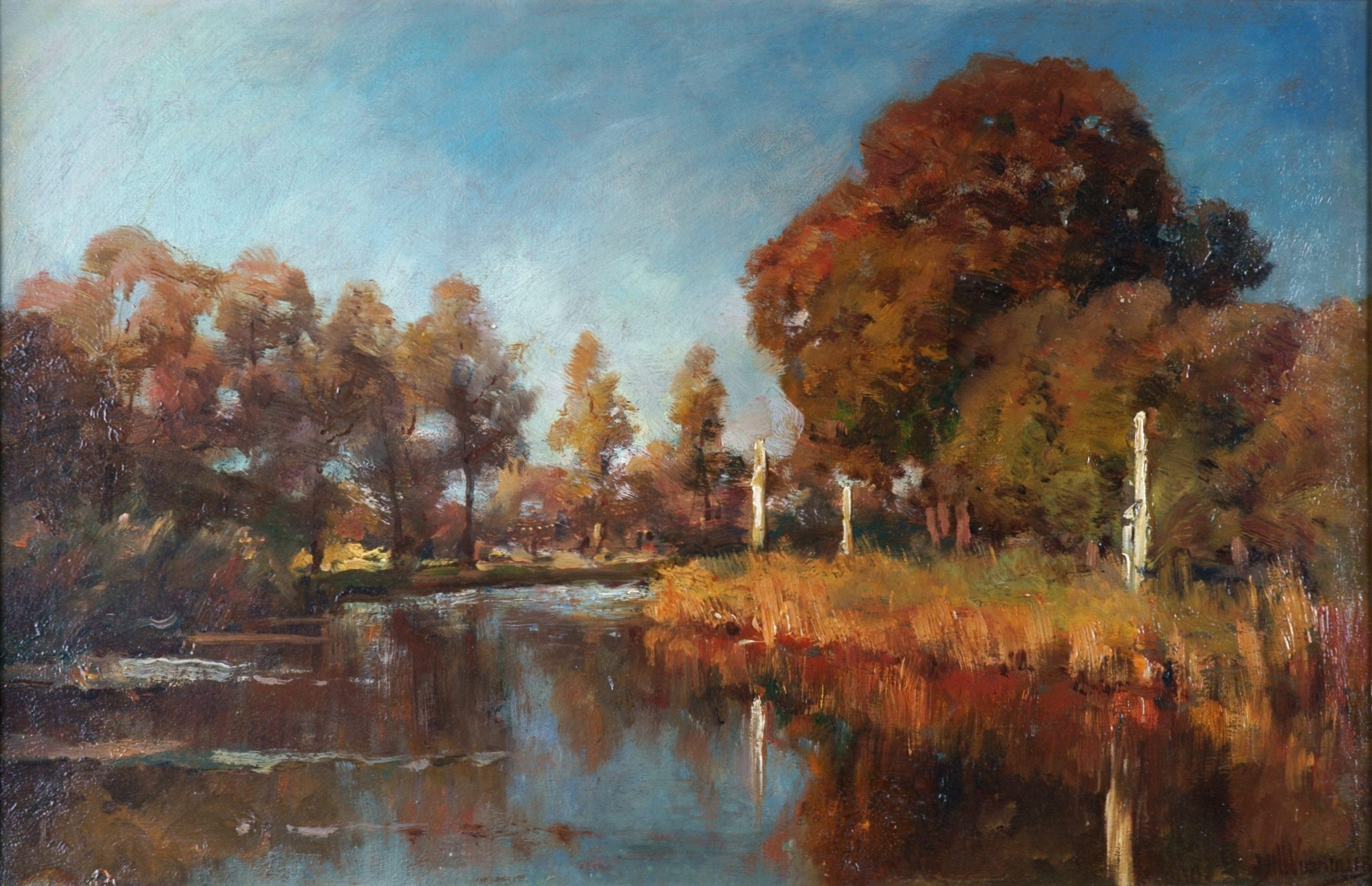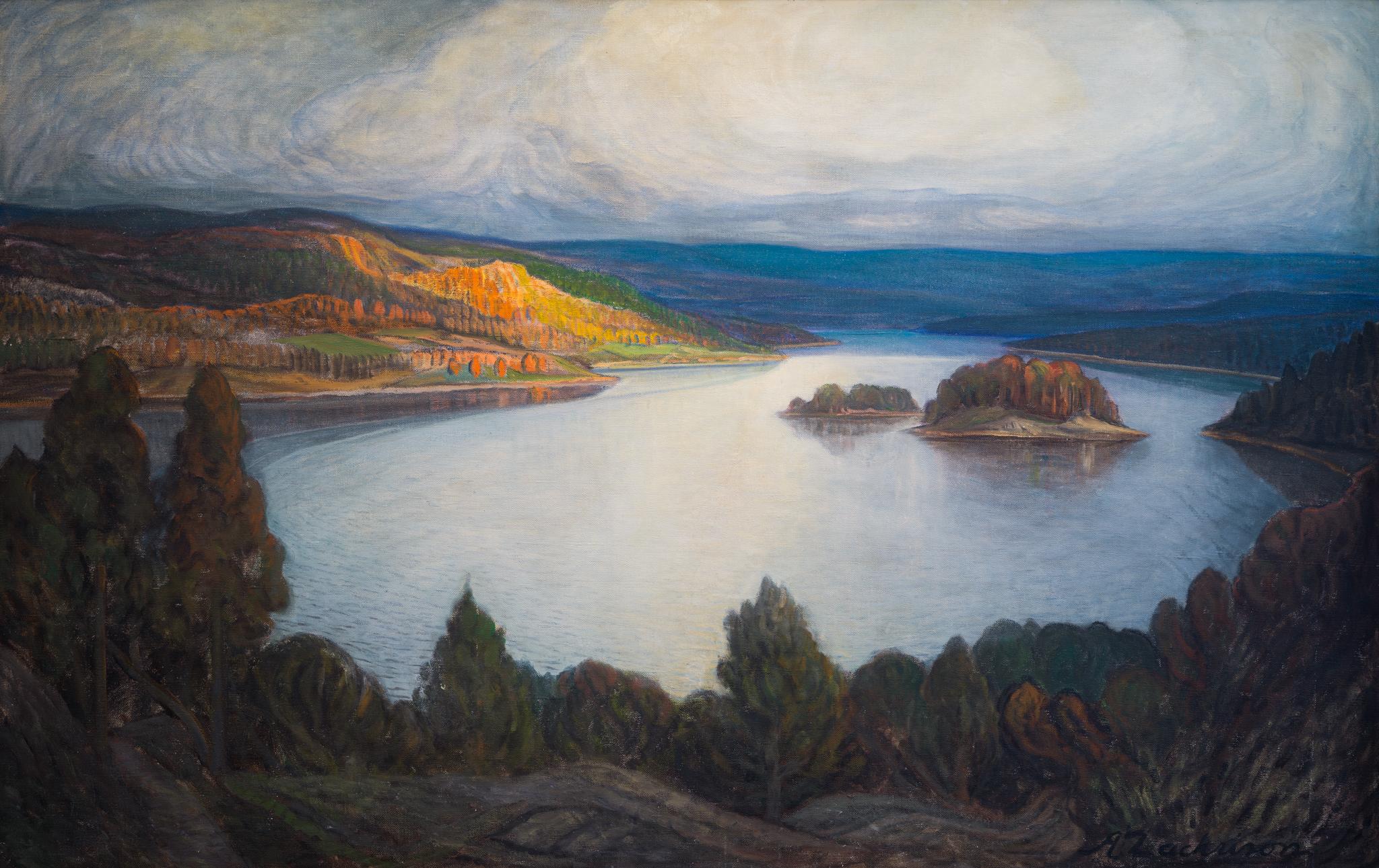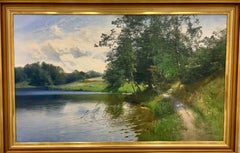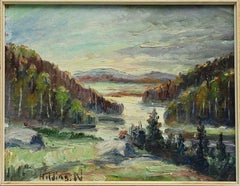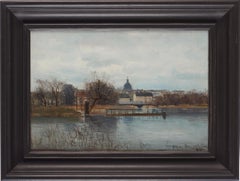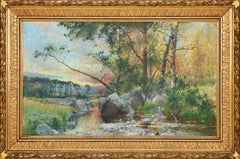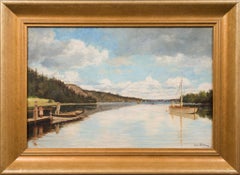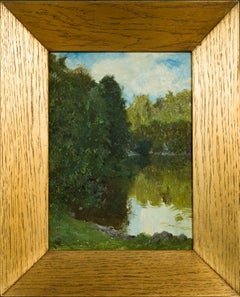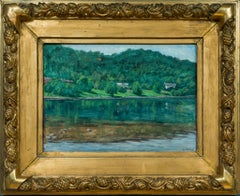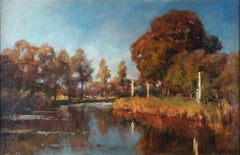Items Similar to The River Silverån in Hässleby, Sweden, Plein air
Want more images or videos?
Request additional images or videos from the seller
1 of 6
Elias ErdtmanThe River Silverån in Hässleby, Sweden, Plein air1883
1883
$1,383.85
£1,024.54
€1,150
CA$1,916.04
A$2,091.85
CHF 1,096.67
MX$25,406.35
NOK 13,695.65
SEK 12,932.35
DKK 8,755.20
About the Item
A fine small river landscape "Silverån" painted "en plein air" by Elias Erdtman, (1862-1945). Signed E. Erdtman and dated 1883. Oil on canvas mounted on board.
This is a rare work from his early period when he was only 21 years old and still studying in Stockholm. He had not yet been abroad. The painting depicts the river Silverån in Hässleby, Småland, in the southeast of Sweden.
Elias Henrik Erdtman was a Swedish artist and in his early years as a young man, he was traveling around Småland with the artist Johan Krouthén dreaming about becoming an artist and did some painting. Our painting, dated 1883, is from his last year of studies at the Technical School in Stockholm, which he had joined in 1881, and one can already see his talent. In 1884 he went to Düsseldorf and stayed there until 1885 with a shorter stay, in between, in Belgium. Then in 1886, he traveled to Paris and Grez-sur-Loing together with his artist friends Ernst Josephson and Carl Larsson.
He participated in most of the Artists' Association exhibitions from 1898 and was on the board of the Artists' Association 1915–20. Erdtman received the Mention honorable award at the World Exhibition in Paris in 1900. He held a number of solo exhibitions in Stockholm and other Swedish citys during the the early 20th century. He worked mostly as a landscape painter and mainly found motifs for his paintings in the Swedish countryside. Erdtman is represented at, among others, Kalmar Art Museum, Norrköping Art Museum and the National Museum in Stockholm.
Oil on canvas mounted on panel, 15 x 24 cm. Signed E. Erdtman and dated 1883.
Verso with text HESSLEBY and 1883. Hässleby-Silverån is today a nature reserve which consists of an ancient long narrow and elongated coniferous forest area next to the river.
- Creator:Elias Erdtman (1863 - 1945, Swedish)
- Creation Year:1883
- Dimensions:Height: 7.68 in (19.5 cm)Width: 11.03 in (28 cm)Depth: 0.99 in (2.5 cm)
- Medium:
- Movement & Style:
- Period:
- Condition:It has recently had a professional surface cleaning and is in a very good condition.
- Gallery Location:Stockholm, SE
- Reference Number:1stDibs: LU2608215628722
About the Seller
5.0
Platinum Seller
Premium sellers with a 4.7+ rating and 24-hour response times
1stDibs seller since 2023
27 sales on 1stDibs
Typical response time: <1 hour
- ShippingRetrieving quote...Shipping from: Stockholm, Sweden
- Return Policy
Authenticity Guarantee
In the unlikely event there’s an issue with an item’s authenticity, contact us within 1 year for a full refund. DetailsMoney-Back Guarantee
If your item is not as described, is damaged in transit, or does not arrive, contact us within 7 days for a full refund. Details24-Hour Cancellation
You have a 24-hour grace period in which to reconsider your purchase, with no questions asked.Vetted Professional Sellers
Our world-class sellers must adhere to strict standards for service and quality, maintaining the integrity of our listings.Price-Match Guarantee
If you find that a seller listed the same item for a lower price elsewhere, we’ll match it.Trusted Global Delivery
Our best-in-class carrier network provides specialized shipping options worldwide, including custom delivery.More From This Seller
View AllSummer Landscape with Lake - 19th Century Oil on Canvas
Located in Stockholm, SE
Large summer landscape by the Swedish artist Alfred Thörne (1850–1916). A footpath leads toward sunlit meadows and trees along the edge of the canal/lake; in the distance a farmstead...
Category
1890s Land Landscape Paintings
Materials
Oil, Canvas
Mountain Landscape, Northern Sweden - Oil on Panel.
Located in Stockholm, SE
A mountainous landscape painted by Hilding Elof Nyman (1870 - 1937). Oil on panel. The motif is probably from Dalarna in Swedens north part were he spent periods of his life. Nyman ...
Category
Early 20th Century Impressionist Landscape Paintings
Materials
Oil, Panel
Stockholm View - Oil on Canvas 1880´s
Located in Stockholm, SE
A view of Stockholm painted from the Royal Park of Djurgården and overlooking the small island of Kastellholmen painted by Alfred Bergström (1869-1930)
The church visible in the background is Katharina church, built in 1695, located in Södermalm, Stockholm.
Signed: Alfr. Bergström, 1887.
Oil on canvas.
A very early work by Bergström when he was only 18 years old. Painted en plein air, probably during the late autumn or early winter of 1887 when he did his first year of study at the Royal Art Academy.
Alfred Maurits Bergström was a Swedish artist and professor at the Royal Academy of Arts. He was a painter, watercolorist and etcher.
During the years 1887–1891 he studied at the Academy and won the Royal Medal...
Category
1880s Naturalistic Landscape Paintings
Materials
Canvas, Oil
$1,588 Sale Price
40% Off
Landscape with Stream - 19th Century Oil on canvas
Located in Stockholm, SE
Arvid Mauritz Lindström (1849–1923) – Fall Landscape
The painting presents a vast autumn landscape illuminated by the soft glow of a setting sun. At the center, a stream winds its wa...
Category
Late 19th Century Naturalistic Landscape Paintings
Materials
Canvas, Oil
Nordic Light over Lake and Mountains - Oil on Canvas Circa 1900
Located in Stockholm, SE
Oil study by a lake and mountains during sunset by Edward Rosenberg (1858-1934). This is a an oil study for a larger painting that Rosenberg did. A te...
Category
Early 20th Century Naturalistic Landscape Paintings
Materials
Oil, Cardboard, Canvas
After the Storm - Oil on Canvas 1910´s
Located in Stockholm, SE
"After the Storm" is the title of this oil painting on canvas by the Swedish artist Hjalmar Berghcrantz (1889–1961). Signed and dated 1917. The artwork depicts a rugged landscape whe...
Category
1910s Naturalistic Landscape Paintings
Materials
Canvas, Oil
You May Also Like
Motif From Långälven in Värmland, Sweden.
Located in Stockholm, SE
This enchanting Swedish painting, dated circa 1890, is believed to depict the tranquil waters of Långälven in Värmland, a testament to Ohlson's prowess in capturing the essence of the Swedish countryside.
The scene is a gentle narrative, where we witness a family moment frozen in time. Parents stand by their daughter on a wooden dock, poised to embark on a journey across the reflective waters. The young girl, dressed in period attire, appears eager and curious, a universal symbol of youth's anticipation for adventure. Her parents, dressed in the fashion of the late 19th century, exude a sense of calm and assurance.
Ohlson's brushwork brings the scene to life with a delicate interplay of light and shadow, mirroring the cloud-speckled sky on the lake's surface. The background is dotted with other vessels, suggesting the shared pleasure of the day's end on the water.
Oscar Ohlson (1847–1912), born in Linneryd, Småland, and later settling in Borås, was a multifaceted artist who, after pursuing law, found his true calling in the arts. A student of Alfred Wahlberg...
Category
1890s Realist Landscape Paintings
Materials
Canvas, Oil
$1,636 Sale Price
20% Off
Expressive Plein Air Study from Engelsberg
Located in Stockholm, SE
This intimate plein air study by Olof Arborelius captures the quiet beauty of a sunlit forest edge reflected in still water. The confident, spontaneous brushwork and delicate handlin...
Category
1880s Impressionist Landscape Paintings
Materials
Oil, Board
Tranquil Reflections – Swedish Summer Landscape by Olof Arborelius
Located in Stockholm, SE
Olof Arborelius (1842-1915) Sweden
Landscape, likely from the Uddevalla area
oil on canvas
signed O.Arb.s
unframed: 25 x 35 cm (9 7/8 x 13 3/4 in)
framed: 43.5 x 53 cm (17 1/8 x 2...
Category
Early 20th Century Post-Impressionist Landscape Paintings
Materials
Canvas, Oil
Late Summer River Landscape / - Realistic Impression -
By Jan Hillebrand Wijsmüller
Located in Berlin, DE
Jan Hillebrand Wijsmuller (1855 Amsterdam - 1925 ibid.), Late Summer River Landscape, oil on canvas, relined, 34 x 56 cm (inside measurement), 43 x 64 cm (frame), signed J[an] H[illebrand] Wijsmuller at lower right.
- in good condition, the frame with isolated bumped spots
- Realistic Impression -
About the artwork
The panoramic landscape format shows a river landscape, with the course of the river, which curves to the right, leading the eye into the depths of the picture and tempting it to continue the landscape in the imagination beyond the visible area. At the same time, however, the fact that the landscape is not visible through the bend in the river focuses our gaze on the entirety of the landscape depicted, without prompting us to focus on distant details. Accordingly, the brushstroke is not designed to render details with realistic precision. In the front left area of the river there is even a completely free brushwork, trained by Impressionism, which nevertheless remains committed to representational and convincingly suggests the movement of the water.
Regardless of the distance of the observer, the entire picture is painted with the same broad brushstroke, so that the landscape is given as an impression. And yet this impression is not ephemeral, as in the case of French Impressionism, to put it exaggeratedly, but reveals to us the essence of the landscape in all its richness. This is why the Dutch variant of Impressionism is always also a realism, although the pictures appear less progressive, but still contain a dimension of landscape painting that is lost with progress.
In the impression, the reality of the landscape is revealed, and this happens as we experience the landscape in the visual impression. Wijsmuller does not depict houses or people in order to allow the experience of the landscape to fully unfold. The experience is determined first and foremost by the river, which does not flow into the picture from our point of view, but towards us. Where the river begins to bend, the water is churned by a rapids. Toward us, the riverbed widens and the water comes to rest, covering the entire width of the foreground like a mirror.
The stillness of the water corresponds to the evening mood of the late summer landscape, in which the warm tones of the evening light blend with the yellow and brown tones of the plants. A gentle, almost idyllic reality, carried by the brushstroke, yet animated by a liveliness that is also made visible by the brushstroke. The broad, dynamically placed brushstrokes evoke the movement of the treetops and animate even the immobile reeds, while the trunks on the right bank, executed in virtuoso white strokes that seem like markings, make the sunlight shine. On the other bank, a carpet of light also spreads out, its energetic effect again expressed in the brushstroke. The dynamic of the landscape is further enhanced by the complementary color contrasts between the greens, yellows, and browns on the one hand and the blue of the all-encompassing sky on the other. A contrast that is intensified by the reflection in the water.
The evening coming to rest of the landscape is thus at the same time an all-encompassing contrasting and yet in itself harmonious movement. This reality becomes accessible to us as an experience in the impression of the landscape.
About the artist
Jan Hillebrand Wijsmuller entered the Royal Academy of Arts in Amsterdam in 1876 and studied under the innovative Professor August Allebé, who was famous for the Amsterdam Impressionism, also known as the Allebé School.
In 1877, Wijsmuller transferred to the Hague Academy of Art, and thus to the Hague School, and then completed his studies at the Brussels Academy of Art. Returning to the Netherlands, Wijsmuller opened his own studio in Amsterdam.
In 1883 he won the prestigious Young Artist Award, donated by Willink van Collen, which made Wijsmuller a well-known and sought-after artist.
Wijsmuller was a member of the Societät Arti et Amicitiae Amsterdam and the Pulchri Studio in The Hague.
Wijsmuller belongs to the second generation of the Hague School. While Vincent van Gogh described the protagonists of the first generation to his brother Theo as "the great gray people," the second generation, and Wijsmuller in particular, used a much more colorful palette. His oeuvre makes him a major player in Dutch Impressionism...
Category
1890s Impressionist Landscape Paintings
Materials
Canvas
$3,658 Sale Price
20% Off
Landscape Painting from Dalsland, Sweden by Axel Zachrison
Located in Stockholm, SE
Axel Zachrison was a Swedish painter known for his landscapes from Dalsland. Born in Tydje, Dalsland, Zachrison's artistic journey was shaped by his experiences at sea and his encounters with influential artists such as Otto Hesselbom, a relative on his mother's side.
This captivating landscape painting titled "Landscape from Dalsland, Sweden" showcases Zachrison's artistic talent and his ability to capture the beauty of nature. The sky, painted in shades of white and gray, features distinct lines around the clouds add a sense of movement and depth to the scene, reminiscent of Hesselbom's painting technique. In the background, we can see some blue mountains, their majestic presence contributing to the overall sense of grandeur.
And In the left part, the viewer can see some land illuminated by the warm rays of the afternoon sun. The vibrant colors of orange, green, and yellow bring the landscape to life, infusing it with a sense of vitality and serenity. A shimmering body of water in the the center, reflecting the luminous white light and creating captivating mirror-like reflections.
The foreground of the painting consists of a darker forest area which skillfully framing the lower part of the composition. This deliberate contrast adds depth and visual interest to the artwork, drawing the viewer's attention to the enchanting scenery.
It's undated but likely executed in the 1920s, the painting carries an undeniable "wow" factor upon first sight. Zachrison's skillful brushwork and his masterful use of decorative color choices create a captivating and immersive experience for the viewer. His ability to evoke emotional responses through his art is a testament to his talent and artistic vision.
Zachrison studied under the guidance of renowned artist Carl Wilhelmson...
Category
1920s Post-Impressionist Landscape Paintings
Materials
Canvas, Oil
River Tay Landscape Scotland - Scottish art Victorian Impressionist oil painting
By Joseph Milne
Located in Hagley, England
A beautiful, large landscape painting, oil on panel, by Scottish listed artist Joseph Milne. The river is the Tay, one of his favourites to paint and the view is from the foot of the tower on Binn Hill with the Fife hills given a little more majesty. This painting is a typical Scottish Impressionist painting with vibrant brushwork. It was painted circa 1900 and is in very good condition in its original frame from W Stewart of Perth. It has various labels verso. Milne exhibited extensively at The Royal Scottish Academy and The Royal Academy. This is a lovely example of an early twentieth century Scottish oil.
Signed left.
Provenance. R. Stewart Perth label verso.
Condition. Oil on panel, image size 30 inches by 22 inches unframed, in fine gallery condition.
Housed in an original Scottish frame 34 by 42 approx framed. In excellent condition.
Joseph (Joe) Milne (1857-1911) was born in Edinburgh in 1857, the elder brother of the painter William Watt Milne (1869-1949) and the father of John Maclauchlan Milne...
Category
19th Century Impressionist Landscape Paintings
Materials
Oil
More Ways To Browse
Eucalyptus Painting
George Williams
Greenwich Paintings
Impressionist Painting Thames
Midcentury Paris Street Painting
Mountain Sunrise
Neutral Landscape Painting
Oil Painting Broadway
Oil Painting Crow
Oil Painting Willows
Opera Set Design
Original Painting Signed T Miles
Round Landscape Painting
Sag Harbor Paintings
Santa Barbara Plein Air Painting
Shirley Brown
Soho Paintings
Stormy Sea Painting
